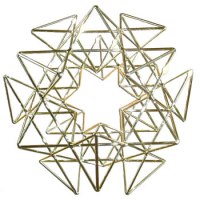Djed

The Djed symbol is one of the more ancient and commonly found symbols in Egyptian mythology. It is a pillar-like symbol in hieroglyphics representing stability. It is associated with Osiris, the Egyptian god of the afterlife, the underworld, and the dead. It is commonly understood to represent his spine.
In the myth of Osiris and Isis, Osiris was killed by Set by being tricked into a coffin made to fit Osiris exactly. Set then had the coffin with the now deceased Osiris flung into the Nile. The coffin was carried by the Nile to the ocean and on to the city of Byblos in Syria. It ran aground and a sacred tree took root and rapidly grew around the coffin, enclosing the coffin within its trunk. The king of the land, intrigued by the tree’s quick growth, ordered the tree cut down and installed as a pillar in his palace, unaware that the tree contained Osiris’s body. Meanwhile, Isis searched for Osiris aided by Anubis, and came to know of Osiris’s location in Byblos. Isis maneuvered herself into the favor of the king and queen and was granted a boon. She asked for the pillar in the palace hall, and upon being granted it, extracted the coffin from the pillar. She then consecrated the pillar, anointing it with myrrh and wrapping it in linen. This pillar came to be known as the pillar of djed.
Osiris
The Tet or Djed Pillar is the oldest symbol of Osiris and was of great religious significance to the ancient Egyptians. It is the symbol of his backbone and his body in general. The Djed is represented on two ivory pieces found at Helwan dating to the first dynasty, evidence that the use of this symbol is at least that old.
Djed as a Tree Of Life
 The Djed is associated with fertility, the phallus, Omphalos, and Tree of Life.
The Djed is associated with fertility, the phallus, Omphalos, and Tree of Life.
As the Djed is actually a phallic symbol, the ceremonial raising of the Djed was enacted as a festival of renewal and fertility, ensuring a bountiful harvest and the appeasement of the gods. It is comparable to the Sumerian counterpart of the temen (temple), and equated with the potency and duration of the pharaoh’s rule.
In relation with the significance of the Djed, we have a long line of Pharaohs who took on the title of the Djed in their name, including the legendary King Djoser do the third dynasty for whom the very first step pyramid was built.
It is generally hypothesized the prefix of DJ equates to Serpent and Wisdom.

- the Ankh – symbol of life – thoracic vertebrae of a bull
- the Djed – symbol of stability – base or sacrum of a bull’s spine
- the Was – symbol of power and dominion – a staff made from a dried bull’s penis
Over time, the djed pillar came to represent the more abstract ideas of stability and permanency, like the Ankh and ‘Was Scepter’ hieroglyphs, commonly used in this sense within decorative friezes. As prehistorical history became recorded, we see various interpretations of the djed pillar.
The Djed represents balance and stability. It has been interpreted as the backbone of the Egyptian god Osiris, especially in the form Banebdjedet (the ba of the lord of the Djedet). Djedu is the Egyptian name for Busiris, a centre of the cult of Osiris.
During the Renewal Festival, the djed would be ceremonially raised as a phallic symbol symbolizing the “potency and duration of the pharaoh’s rule”. It has been compared to the Sumerian concept of temen. The hieroglyph for “djed” may have given rise to the letter Samekh. Ptah, and Tatenen, are also sometimes referred to as the noble Djed.
It was sometimes surmounted by a small capital (or perhaps more correctly, an abacus used to support the architrave), and often stands on a rectangular base. Some depictions of the pillar portray it with human arms holding the royal regalia. In representations and in other instances, such as amulets, the djed pillar could be depicted as flat, but at other times it was produced as a fully round pillar.
In ancient Egypt, various theologies developed to encompass a number of different concepts, such as creation, that were explained by varying mythologies. These concepts sometimes varied by region, or with time. For this reason, it is really somewhat difficult to determine how the concept of the djed pillar actually originated in the prehistoric period and it is likely that any such efforts are purely speculative and perhaps metaphoric.
As a fetish symbol, its origins seem to lie in the Predynastic period. Some scholars such as Manfred Luker have suggested that it might have originally represent a pole, perhaps with fertility associations. around which grain or corn was tied.
Ceremonial Use – Raising the Djed Pillar
A scene on the west wall of the Osiris Hall at Abydos shows the raising of the Djed pillar.

Isis and Seti

It was probably at Memphis that kings first performed a ceremony known as “raising the djed pillar”, which not only served as a metaphor for the stability of the monarch, but also symbolized the resurrection of Osiris. Our best record of this ceremony comes from a depiction in the Osiris Hall at Abydos. It was eventually incorporated into one of the Sed Festivals of Amenhotep III at Thebes.
This ceremony, performed as early as the Middle Kingdom, took place at the time when the flooding was at its height. Overall known as the Feast of Khoiak, it began with an effigy of the dead god, cast in gold and filled with a mixture of sand and grain. As the waters were receding from the inundation and grain was being planted in the land, the effigy was watered daily. Then, for three days, it was floated on the waters of the Nile, and on the twenty-fourth day of the ancient Egyptian month of Khoiak, it was placed in a coffin and laid in a grave. On the thirtieth day, the effigy was actually buried.
This seven day delay represented the god’s seven-day gestation in the womb of Nut, his mother. On the last day, the king and priests raised a djed pillar as a symbol of Osiris’ rejuvenation and strength, apparently at a placed in the Delta known as Djedu (Greek Busiris). Now, the land would be fertile for yet another year. The next day marked the four month long season of Pert (Going Forth) during which the land appeared to rise up out of the flood waters allowing the fields to be planted.
Raising ConsciousnessThe djed was considered necessary to aid in the transformation of

the physical body into its spiritual form of consciousness and light.
Raising the Kundalini
It was speculated that throughout ancient Egypt the common belief was that semen was reproduced in the spinal fluids, hence the worship of the erect spine as a symbol of cosmic regeneration. This practice continued on with the Hindu traditions of Kundalini enlightenment and awakening the “fire serpent” which resides in the chakras.
The Djed in ArchitectureIn the Old Kingdom, the pillar was shown in wall decorations at the Step Pyramid at Saqqara. In these drawings, the djed pillars were shown in the royal palace where they formed columns supporting windows. When one looked through the windows, the pillars gave the appearance of holding up the sky beyond.
Also found at Saqqara

Arches


Ptah is sometimes described as “The Noble Djed”.Ptah is often depicted holding the djed symbol as a staff, and lending further support to this theory are the bands found below the crossbars of some djed pillars that correspond to the papyrus and other columns in ancient temples, which symbolically held together the papyrus stalks.
It should be noted that the four gods who were responsible for holding up the sky were the Four Sons of Horus, and it is interesting to note that they were associated with the four canopic jars that contained the organs of the dead, which often had depictions of djed pillars adorning the exterior of the chest that held the jars. They also provided various services to the dead in the afterlife, strongly relating them to Osiris.
The Isis Knot
The Isis knot (tiet) also called “The Blood of Isis” is believed to be a stylized rendering of female genitalia symbolizing the womb of the Goddess. Isis was the wife of Osiris, god of nature, death and resurrection whose backbone was the djed pillar.
The four rungs of the djed pillar represented the four elements and dimensions of the created world. Embodying the divine masculine and the creative feminine principles, the tiet knot and the djed pillar together provided powerful protection and were two of the most popular amulets in ancient Egypt.
This takes us to Isis as an archetype for Female Creator, blood, human bloodlines stories, which we trace from Egypt and Mother Mary, Jesus and Mary Magdalene.
The Djed at the Temple of Hathor at Dendera

Did the ancient Egypt harness the power of electricity?

Horace connecting the pillar with the loop and ankh.

Djed Pillar and Geometry


Funnels, Cones, Horns, Harmonics of Creation
Spiraling Creation
Astronomy and Astrology

This image above shows the ahker of the two horizons, two lion-headed sphinx-like figures facing opposite directions, falling on the Leo/Virgo and Aquarius/Pisces equinox axis and crossed by the Djed pillar marking the galactic meridian of center/edge. In this arrangement, the celestial polar axis does fix the midpoint of the ahker, the place where the Djed rises, but the Djed orientation itself is 90 degrees from the polar axis. This shows that Timms had intuited the correct orientation for the primal Djed and its connection with the Great Cross of the galactic alignment.
Related articles
- Crowley And The Nine – Interpretatio Chaotica (runesoup.com)
- Who is Osiris? (gnosticwarrior.com)
- osiris 1.1 (pypi.python.org)
- Abydos: Egyptian Tombs & Cult of Osiris (2eyeswatching.com)
- The Pagan Origin of Christianity (thecontroversialfiles.net)
- Egyptian Statue Begins Spinning ON ITS OWN (usahitman.com)
- Abydos: Egyptian Tombs & Cult of Osiris (mannaismayaadventure.com)
- osiris 1.0 (pypi.python.org)












